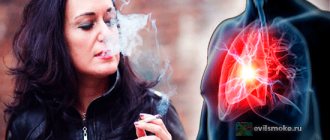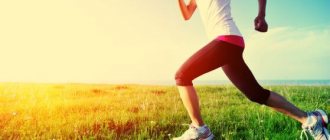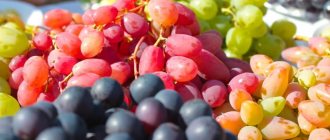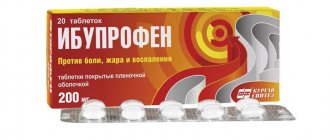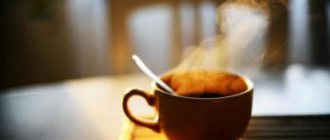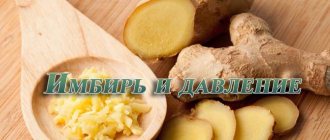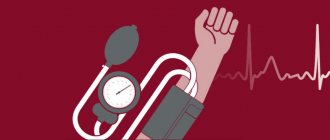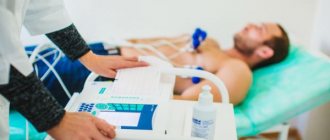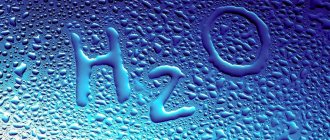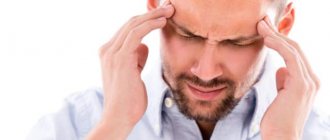- Do cigarettes cause hypertension?
- Can hypertensive patients smoke?
- The effect of smoking hookahs on blood pressure
- What are the effects of electronic cigarettes?
- What complications can there be?
- Will hypertension go away if you quit smoking?
All smokers are aware that nicotine, which is contained in cigarette smoke, has a great effect on the human vascular system. Consequently, an addiction can also affect blood pressure. But the question of whether blood pressure levels decrease or increase when smoking is worth understanding.
Do cigarettes cause hypertension?
As soon as a person takes the first puff, the harmful substances contained in the cigarette penetrate the circulatory system and provoke vasoconstriction. Blood begins to circulate worse and reduces nutrition to vital organs, which causes blood pressure to increase. To compensate for the damage, the heart has to contract more intensely so that blood gets to the right place faster. The plaques formed in the walls do not disappear anywhere, as a result of which hypertension develops.
In addition, nicotine entering the bloodstream stimulates the adrenal glands to function. Thus, adrenaline is produced, which provokes rapid heart contractions. In addition to an increase in blood pressure, there is a high risk of developing arrhythmia.
Baroreceptors are also involved in regulating vascular tone. They are responsible for adjusting the pressure in various cases. The systematic penetration of nicotine into the blood inhibits their functioning, causing the regulation process to deteriorate.
Can hypertensive patients smoke?
When asked whether a hypertensive patient can smoke, the answer can be answered with confidence - no. Tobacco smoking in hypertension aggravates the already serious condition of the body. Unfortunately, many smokers are of the opinion that since the disease has already developed, there is no point in getting rid of the addiction.
With each smoked pack, changes in the condition of blood vessels progress; in addition, other harmful effects are produced, for example, carcinogenic. Diseases resulting from smoking should signal a person about the catastrophic effect of nicotine on the body, and encourage him to get rid of the addiction.
The effect of smoking hookahs on blood pressure
When smoking hookahs, just like regular cigarettes, the smoker's blood pressure increases. If we take into account the harm caused to the body from tobacco products, the smoke that is released during hookah smoking is less dangerous, despite the fact that the process itself takes much longer.
However, you should not think that this method of smoking is completely harmless to health, since blood pressure still increases. The reason for this is carbon monoxide. It is formed due to the fact that the coals that heat the tobacco mixture burn throughout the entire process. When smoking a hookah, very little oxygen penetrates into the blood and brain, for this reason a person experiences increased blood pressure, headaches and nausea.
What are the effects of electronic cigarettes?
Nicotine, which is contained in various mixtures for electronic cigarettes, helps to increase the stiffness of blood vessels. And the autonomic nervous system reacts with stress to what is happening. Blood pressure rises in smokers who prefer both regular tobacco products and vapor generators.
Due to the fact that blood pressure is constantly elevated, hypertension develops. Regardless of how the poison enters the bloodstream, the body’s defense reactions always work to remove it or compensate for the dangerous effect.
If you choose between these two smoking methods, you should still give preference to steam generators, especially if you use mixtures without nicotine. For heavy smokers, an e-cigarette can help you gradually quit the bad habit. However, non-smokers should not start, as addiction can quickly develop.
About types of tobacco use
There is an opinion that only smoking is dangerous, and blood pressure rises with active cigarette smoking. Nicotine resins contain tobacco leaves, so all products made from it release nicotine:
- cigars;
- e-Sigs;
- chewing tobacco leaves.
See also: How to measure blood pressure at home?
Smoking affects blood pressure through passive smoke inhalation (if people smoke nearby).
Hookah increases blood pressure provided that the smoking mixture includes tobacco, and the basis of most hookah mixtures is tobacco leaf.
What complications can there be?
People who are faced with hypertension need to urgently get rid of the addiction, as it is very dangerous for their health. Let's consider what complications may arise if you continue to smoke with hypertension:
- The main threat to a smoker is atherosclerosis. The disease develops due to the formation of deposits called “plaques” on the vascular walls. After some time passes, the paths through which blood flows decrease and blood clots appear.
- When the vessels of the brain are affected, there is a risk of a stroke, after which a person may lose speech, motor activity, memory, etc.
- If the coronary arteries, which are responsible for supplying blood to the heart, are damaged, a person may experience angina. And when the coronary arteries become completely blocked, myocardial infarction occurs.
- Under the influence of nicotine hypertension on the body, renal functioning is impaired.
- A smoker may also experience varicose veins. It is manifested by severe swelling, protruding veins, pain and an unattractive appearance.
Long-term consequences of using tobacco products
If we consider the question of whether long-term smoking increases or decreases blood pressure, then the answer is clear: it leads to constantly high blood pressure in a person, the occurrence of hypertension.
Adrenaline stimulates the internal walls of blood vessels, which provokes a gradual decrease in their elasticity, cholesterol plaques settle on the walls, and blood clots occur. The vessels lose their elasticity, their lumen narrows, and it is harder for the heart to push blood through them. With elevated blood pressure, arterial hypertension develops, which increases the risk of myocardial infarction.
Hypertension of the renal, hepatic, and pulmonary arteries provokes malfunctions of these organs. The effect of tobacco smoke on the heart muscle is especially strong. Long-term smoking provokes disturbances in heart contractions and contributes to the development of myocardial infarction. This disease affects smokers 8 times more often than non-smokers. Ischemic disease (lack of oxygen to the heart muscle) affects smokers 40% more often.
Failures in the functioning of the pulmonary arteries lead to breathing problems, decreased resistance of the bronchi, bronchioles, and alveoli of the lungs, infections; smokers suffer from bronchitis 6-7 times more often than non-smokers. Constriction of the pulmonary vessels reduces the amount of oxygen entering the body. All organs and systems suffer from oxygen starvation.
See also Treatment of arterial hypertension 1st degree
Will hypertension go away if you quit smoking?
Immediately after getting rid of a bad habit, the pressure does not normalize. Initially, it may even seem that the condition has only worsened, this is due to the fact that the body, accustomed to systematically receiving a dose of nicotine, begins to rebel. It can react completely differently, depending on individual characteristics. Very often, negative symptoms worsen in the first few days. Coughing, shortness of breath, and even weight gain may occur.
However, after some time, the condition will begin to improve, the functioning of internal organs will be restored, and the pressure will decrease. With constantly high blood pressure, the risk of persistent hypertension and its transition to a severe form is significantly reduced. The establishment of the cardiovascular system occurs within 1.5 months, and complete restoration of the body takes as many as 5 years.
Everyone has the right to decide for themselves what lifestyle to lead. However, it is worth considering the fact that, together with unstable blood pressure, an addiction can provoke the development of many serious diseases and lead to irreversible consequences. All this can only be avoided with a healthy lifestyle.
Who is assigned table number 10 and what is its benefit?
Have you been struggling with HYPERTENSION for many years without success?
Head of the Institute: “You will be amazed at how easy it is to cure hypertension by taking it every day...
Read more "
If you have heart problems, doctors recommend following diet No. 10. It helps improve blood circulation, and also has a beneficial effect on the condition of the stomach, liver and kidneys, normalizes metabolism, and is relevant for hypertension.
Indications for diet
- Heart disease is a pathology in the structure of its structure that causes heart failure.
- Cardiosclerosis is a disease in which scars appear on the heart, causing its contractile function to be impaired.
- Tendency to hypertension or already high blood pressure.
- Circulatory failure of the first and second degrees is a condition in which the circulatory system cannot cope with the timely delivery of blood to all organs and tissues. Accordingly, they do not receive sufficient amounts of oxygen and nutrients, which is why the functions they perform are impaired.
- Other cardiovascular diseases.
- Kidney problems (stones, kidney failure).
- Liver dysfunction due to the accumulation of many toxic substances and fats in it.
- Stomach diseases (gastritis, ulcers, heartburn).
The essence of diet No. 10
The main requirement of diet number 10 is to reduce or eliminate salt intake and reduce the amount of liquid you drink (up to 1.2 liters). This condition is especially relevant for hypertension. It also involves reducing caloric intake due to fats and quickly broken down carbohydrates.
The dietary table assumes that the food consumed contains potassium and magnesium, lipotropic substances (they participate in the metabolism of fats and prevent their deposition in the liver), alkaline compounds (reduce acidity).
When cooking food, preference is given to boiling, steaming, and baking. It is worth excluding foods that are difficult for the stomach to digest. Food temperature: moderately warm or room temperature. Excessively hot or cold dishes are excluded.
Diet number 10 requires regularity of meals, the number of which should be at least 5-6 times a day. The last snack in the evening should not be taken less than two hours before bedtime.
The calorie content of food eaten per day is up to 2500 kcal.
The daily amount of salt consumed is between four and six grams.
The chemical composition of the daily diet is as follows:
- Proteins - 90 g, of which 50% are of animal origin.
- Carbohydrates - 400 g.
- Fats - 70 g, 20% of them are vegetable.
Useful and harmful
To understand what Diet 10 allows and what you will have to give up, consider the following food products:
- Bakery products. It is worth giving preference to yesterday's slightly dried bread made from wholemeal flour of the first and second grade. Choose one that is prepared without salt. As for treats, you can treat yourself to savory cookies or biscuits. Avoid baked goods and puff pastry products, as they are made from the highest grade of flour and contain a lot of butter or margarine and sugar. You should also avoid pancakes and pancakes, as they are prepared by frying.
- Meat. You can eat, but lean: beef, veal, pork (without fat), rabbit, turkey, chicken. But you should give up duck and goose meat. You should also not eat animal entrails. Meat should be cooked only after preliminary cooking. This means that you need to clean it of tendons and fascia and boil it a little in water, which is then drained, and along with it the fat. Next, the meat is prepared according to the recipe. It can be thrown into soup, baked, cooked into cutlets, meatballs, even lightly fried in a small amount of oil. It is forbidden to eat smoked meat, canned meat, and sausages (with the exception of diet and doctor's sausages, but they can be consumed in limited quantities).
- Eggs. A maximum of one egg per day is allowed, which can be soft-boiled, steamed or baked. You cannot eat hard-boiled or fried eggs.
- Fish. You can eat only low-fat varieties: boil, bake, steam, fry after cooking (frying in this case lasts a couple of minutes only to give the dish a crust). You cannot eat salted, smoked fish, fatty fish, canned food and caviar.
- Dairy products. Anything with a low fat content without adding salt, sugar or spices is allowed. That is, you cannot eat: salty cheese, fatty cottage cheese, store-bought yoghurts, sweet cheeses, sour cream, cream (but they can be added little by little to dishes).
- Cereals and pasta. With diet No. 10, everything is allowed, you just need to prepare them correctly - boil them in water or milk, make casseroles from cereals, without using salt and large amounts of sugar and fat.
- Legumes. There is a strict ban on them.
- Vegetables. It is preferable to boil or bake, but you can also eat raw. There are restrictions on the consumption of white cabbage and green peas.
With diet 10, patients should give up spinach, radishes, garlic, onions, and sorrel. You should not eat vegetable marinades, salted or fermented foods. This is especially important for those who suffer from hypertension.
Let's continue to analyze the list of products to understand what diet number 10 is:
Why do you feed pharmacies if hypertension is afraid of the usual like fire...
Tabakov has revealed a unique remedy against hypertension! To reduce blood pressure while preserving blood vessels, add to…
- Mushrooms. It is forbidden to eat them.
- Fruits. You can eat soft varieties that will not irritate the stomach and intestines. Avoid foods with coarse fiber. Dried fruits are allowed.
- Sweets. The diet does not prohibit their consumption in moderation, but some of them are unacceptable: chocolate, cakes with butter or cream, buns. You can eat jam, marmalade, jelly, honey, non-chocolate candies, mousses.
- Fats. They are allowed in small quantities. Doctors recommend giving preference to butter or vegetable oil. With diet No. 10, lard, beef and lamb fats are prohibited.
- Sauces. You can eat milk, sour cream, vegetable, tomato sauces (100-150 grams per day). You should avoid dressings made from meat, fish, and mushrooms. Be sure to exclude store-bought mayonnaise.
- Spices. Allowed: bay leaf, citric acid, vanilla sugar, cinnamon. You cannot eat mustard, horseradish, or pepper. It is especially important to remember this rule for heart patients and those who suffer from hypertension.
- Beverages. The main thing is to give up cocoa and natural coffee. You shouldn't overuse black tea either. When choosing green, check the composition so that there are no herbs that affect the functioning of the cardiovascular system, herbs with diuretic or laxative properties. After all, during a diet, the body is already subject to a load in the form of adaptation to the new regime. Sugary carbonated drinks and alcohol are prohibited. What drink? Freshly squeezed juices, compotes, jelly, milk (low-fat), boiled water; Rosehip decoction has a positive effect on the body.
Sample menu for the week
Based on the above, you can think through a menu that allows for diet No. 10. It is recommended to have breakfast at 7-8 am, lunch at 10-11 am, lunch at 13-14 o'clock, afternoon tea at 16:00 and dinner at 18-19 o'clock. An hour before bedtime, another snack is recommended.
So, let’s create a sample menu for diet No. 10 for the week:
Monday:
- Breakfast - oatmeal, steamed omelette, chicory drink.
- Lunch - fruit puree.
- Lunch - baked beef (up to 150 g), noodle soup without meat, dried slice of bread, dried fruit compote.
- Afternoon snack - banana.
- Dinner - steamed fish cutlet, vegetable stew, rosehip broth.
- Before going to bed - a glass of kefir with a fat content of 0-1%.
Tuesday:
- Breakfast - rice porridge with carrots and pieces of cauliflower, cheese casserole, weak tea.
- Lunch - persimmon.
- Lunch - boiled chicken breast, buckwheat soup, bread toast, fruit compote.
- Afternoon snack - rosehip decoction, 3 pcs. Maria cookies.
- Dinner - mashed potatoes, baked fish, dried fruit compote.
- Before bed - a glass of yogurt.
Wednesday:
- Breakfast - boiled pasta with vegetable sauce and sour cream, soft-boiled egg, chicory drink.
- Lunch - baked apples and pears.
- Lunch - pearl barley soup, low-fat pork roll with vegetable filling, a piece of bread, jelly.
- Afternoon snack - rosehip decoction, not chocolate candy.
- Dinner - stewed zucchini, steamed turkey cutlet, cottage cheese casserole with pieces of fruit, weak tea.
- Before bed - a peach, 2-3 pieces of melon or other fruit.
Thursday:
- Breakfast - barley porridge with vegetable gravy, baked rabbit, freshly squeezed fruit juice.
- Lunch - berries, for example, mulberries.
- Lunch - beetroot soup, lightly fried fish (previously boiled), bread, compote.
- Afternoon snack - jelly.
- Dinner - baked potatoes, soft-boiled egg, boiled cauliflower, weak tea.
- Before bed - a glass of kefir.
Friday:
- Breakfast - semolina porridge with fruit, baked omelet, rosehip infusion.
- Lunch - banana.
- Lunch - buckwheat soup, baked beef, jelly.
- Afternoon snack - rosehip decoction with a piece of biscuit.
- Dinner - boiled beets, pilaf without meat, weak tea.
- Before bed - cottage cheese 0-5% fat with dried fruits.
Saturday:
- Breakfast - oatmeal, a piece of boiled chicken breast, freshly squeezed juice.
- Lunch - bread toast with jam, weak tea.
- Lunch - steamed fish cutlet, millet soup, vegetable stew, compote.
- Afternoon snack - fruit allowed by the diet.
- Dinner - seaweed salad, barley porridge, soft-boiled egg.
- Before bed - a small portion of milk porridge with rice.
Sunday:
- Breakfast - pasta with tomato sauce, a piece of doctor's sausage, a chicory drink.
- Lunch - fruit puree.
- Lunch - boiled fish, soup with rice, jelly with biscuits.
- Afternoon snack - rosehip decoction.
- Dinner - omelet, vinaigrette, pumpkin porridge, weak tea.
- Before bed - a glass of yogurt.
As you can see, you can eat a varied and tasty diet by following diet No. 10. At the same time, improve the functioning of all internal organs, especially the heart, liver, kidneys and stomach. In addition, the diet leads to normalization of hypertension and metabolism, so obese people lose weight, and thin people gain weight.
